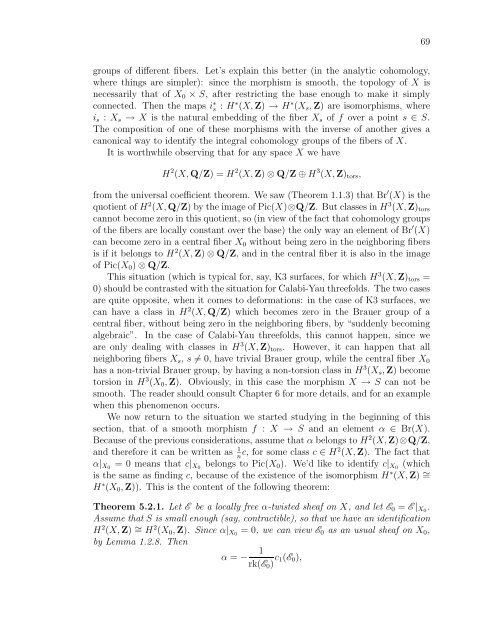derived categories of twisted sheaves on calabi-yau manifolds
derived categories of twisted sheaves on calabi-yau manifolds
derived categories of twisted sheaves on calabi-yau manifolds
You also want an ePaper? Increase the reach of your titles
YUMPU automatically turns print PDFs into web optimized ePapers that Google loves.
groups <str<strong>on</strong>g>of</str<strong>on</strong>g> different fibers. Let’s explain this better (in the analytic cohomology,<br />
where things are simpler): since the morphism is smooth, the topology <str<strong>on</strong>g>of</str<strong>on</strong>g> X is<br />
necessarily that <str<strong>on</strong>g>of</str<strong>on</strong>g> X0 × S, after restricting the base enough to make it simply<br />
c<strong>on</strong>nected. Then the maps i ∗ s : H ∗ (X, Z) → H ∗ (Xs, Z) are isomorphisms, where<br />
is : Xs → X is the natural embedding <str<strong>on</strong>g>of</str<strong>on</strong>g> the fiber Xs <str<strong>on</strong>g>of</str<strong>on</strong>g> f over a point s ∈ S.<br />
The compositi<strong>on</strong> <str<strong>on</strong>g>of</str<strong>on</strong>g> <strong>on</strong>e <str<strong>on</strong>g>of</str<strong>on</strong>g> these morphisms with the inverse <str<strong>on</strong>g>of</str<strong>on</strong>g> another gives a<br />
can<strong>on</strong>ical way to identify the integral cohomology groups <str<strong>on</strong>g>of</str<strong>on</strong>g> the fibers <str<strong>on</strong>g>of</str<strong>on</strong>g> X.<br />
It is worthwhile observing that for any space X we have<br />
H 2 (X, Q/Z) = H 2 (X, Z) ⊗ Q/Z ⊕ H 3 (X, Z)tors,<br />
from the universal coefficient theorem. We saw (Theorem 1.1.3) that Br ′ (X) is the<br />
quotient <str<strong>on</strong>g>of</str<strong>on</strong>g> H 2 (X, Q/Z) by the image <str<strong>on</strong>g>of</str<strong>on</strong>g> Pic(X)⊗Q/Z. But classes in H 3 (X, Z)tors<br />
cannot become zero in this quotient, so (in view <str<strong>on</strong>g>of</str<strong>on</strong>g> the fact that cohomology groups<br />
<str<strong>on</strong>g>of</str<strong>on</strong>g> the fibers are locally c<strong>on</strong>stant over the base) the <strong>on</strong>ly way an element <str<strong>on</strong>g>of</str<strong>on</strong>g> Br ′ (X)<br />
can become zero in a central fiber X0 without being zero in the neighboring fibers<br />
is if it bel<strong>on</strong>gs to H 2 (X, Z) ⊗ Q/Z, and in the central fiber it is also in the image<br />
<str<strong>on</strong>g>of</str<strong>on</strong>g> Pic(X0) ⊗ Q/Z.<br />
This situati<strong>on</strong> (which is typical for, say, K3 surfaces, for which H 3 (X, Z)tors =<br />
0) should be c<strong>on</strong>trasted with the situati<strong>on</strong> for Calabi-Yau threefolds. The two cases<br />
are quite opposite, when it comes to deformati<strong>on</strong>s: in the case <str<strong>on</strong>g>of</str<strong>on</strong>g> K3 surfaces, we<br />
can have a class in H 2 (X, Q/Z) which becomes zero in the Brauer group <str<strong>on</strong>g>of</str<strong>on</strong>g> a<br />
central fiber, without being zero in the neighboring fibers, by “suddenly becoming<br />
algebraic”. In the case <str<strong>on</strong>g>of</str<strong>on</strong>g> Calabi-Yau threefolds, this cannot happen, since we<br />
are <strong>on</strong>ly dealing with classes in H 3 (X, Z)tors. However, it can happen that all<br />
neighboring fibers Xs, s = 0, have trivial Brauer group, while the central fiber X0<br />
has a n<strong>on</strong>-trivial Brauer group, by having a n<strong>on</strong>-torsi<strong>on</strong> class in H 3 (Xs, Z) become<br />
torsi<strong>on</strong> in H 3 (X0, Z). Obviously, in this case the morphism X → S can not be<br />
smooth. The reader should c<strong>on</strong>sult Chapter 6 for more details, and for an example<br />
when this phenomen<strong>on</strong> occurs.<br />
We now return to the situati<strong>on</strong> we started studying in the beginning <str<strong>on</strong>g>of</str<strong>on</strong>g> this<br />
secti<strong>on</strong>, that <str<strong>on</strong>g>of</str<strong>on</strong>g> a smooth morphism f : X → S and an element α ∈ Br(X).<br />
Because <str<strong>on</strong>g>of</str<strong>on</strong>g> the previous c<strong>on</strong>siderati<strong>on</strong>s, assume that α bel<strong>on</strong>gs to H 2 (X, Z)⊗Q/Z,<br />
and therefore it can be written as 1<br />
n c, for some class c ∈ H2 (X, Z). The fact that<br />
α|X0 = 0 means that c|X0 bel<strong>on</strong>gs to Pic(X0). We’d like to identify c|X0 (which<br />
is the same as finding c, because <str<strong>on</strong>g>of</str<strong>on</strong>g> the existence <str<strong>on</strong>g>of</str<strong>on</strong>g> the isomorphism H ∗ (X, Z) ∼ =<br />
H ∗ (X0, Z)). This is the c<strong>on</strong>tent <str<strong>on</strong>g>of</str<strong>on</strong>g> the following theorem:<br />
Theorem 5.2.1. Let E be a locally free α-<str<strong>on</strong>g>twisted</str<strong>on</strong>g> sheaf <strong>on</strong> X, and let E0 = E |X0.<br />
Assume that S is small enough (say, c<strong>on</strong>tractible), so that we have an identificati<strong>on</strong><br />
H 2 (X, Z) ∼ = H 2 (X0, Z). Since α|X0 = 0, we can view E0 as an usual sheaf <strong>on</strong> X0,<br />
by Lemma 1.2.8. Then<br />
α = − 1<br />
rk(E0) c1(E0),<br />
69
















